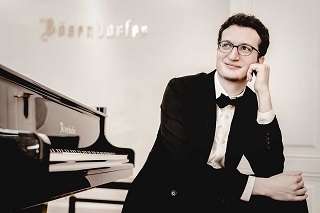|
Back
Beethoven and Mahler Continue Stunning Palm Beach Season Palm Beach
Kravis Center for the Performing Arts
03/07/2022 -
Ludwig van Beethoven: Piano Concerto No. 3 in C Minor, Op. 37
Gustav Mahler: Symphony No. 4 in G Major
Emily Finke (soprano), Rodolfo Leone (piano)
Palm Beach Symphony, Gerard Schwarz (conductor)

R. Leone (© Andrej Grilc)
In a season of hit performances, the Palm Beach Symphony continues to buck the national trend as it rises in popularity and quality of performance. This thoughtful combination of one of Beethoven’s most popular piano concerto with Mahler’s uncharacteristically upbeat Symphony No. 4 played to the ensemble’s greatest strengths. In his greatest achievement in Palm Beach to date, Maestro Gerard Schwarz led with a firm but airy sweep, allowing all the resonances to emerge in dazzling relief. “Mesmerizing” was the most used adjective at a post‑concert dinner, and for good reason.
In honor of the courage of the Ukrainian people now battling Russian aggression for their liberty, Maestro Schwarz opened the concert with Ukraine’s national anthem, the translated title of which means “Ukraine Has Not Yet Perished.” Its inherent defiance resounded in a powerful but dignified performance from the ensemble, some of whose members hail from that part of the world. Throughout the evening, the stage was backlit by the blue and yellow of the Ukrainian flag.
Beethoven launched the regularly scheduled program. The announced soloist Maria João Pires was unable to appear, but the Symphony made a real find in the 28- year old Italian pianist Rodolfo Leone, who played with an impressive fluency that balanced well with the orchestra and its ebullient exposition of motifs. Leone’s versatility was on particularly impressive display as the work moved from the concerto’s somber “Largo” second movement to its rosier conclusion in the “Rondo” finale.
The second part of the program was devoted to Mahler’s symphony, which the composer wrote during two lakeside summers in 1899 and 1900 while he was on vacation from his post as director of Vienna’s Court Opera. “Light” is a word rarely associated with Mahler, most of whose works are imbued with dark emotional anguish and the deep despairs of fin- de– siècle life. But his Fourth Symphony reflects the bucolic surroundings of its composition with easy-going and sometimes even playful elements. Its second movement employs a tuned- down violin to suggest a devilish sound that can be either menacing or fanciful. Maestro Schwarz helpfully illustrated the technique in a brief introductory talk before taking the podium. The symphony’s concluding movement, noted Sehr behaglich (“very comfortable”), invokes the heavens, with a solo soprano part invoking saints in heaven as they prepare for a feast. Adapted from a song Mahler wrote in 1892 called The Heavenly Life (Das himmlische Leben), it emerged admirably in the limpid voice of the talented young soprano Emily Finke. Throughout the Symphony, Maestro Schwarz relied on a relaxed tempo to allow his solid strings and resonant horns to deliver a superb playing. A Mahler Fifth Symphony should certainly be on the horizon in future seasons, if it is not already.
Palm Beach’s 48th season will close on April 10, with an intriguing concert of works by Dvorák, Korngold, and the American composer William Schuman. With performances of this standard, it is not to be missed. We can only wait with great anticipation for the 49th season!
Paul du Quenoy
|